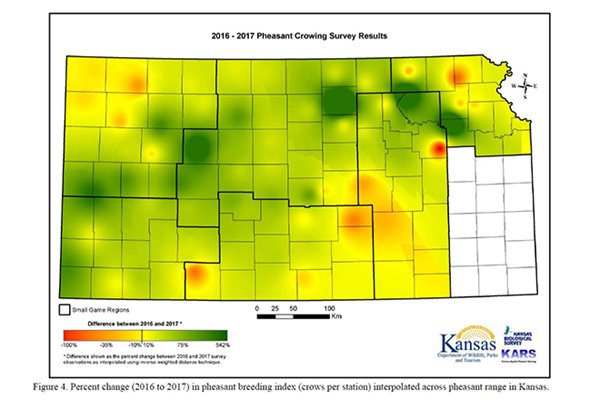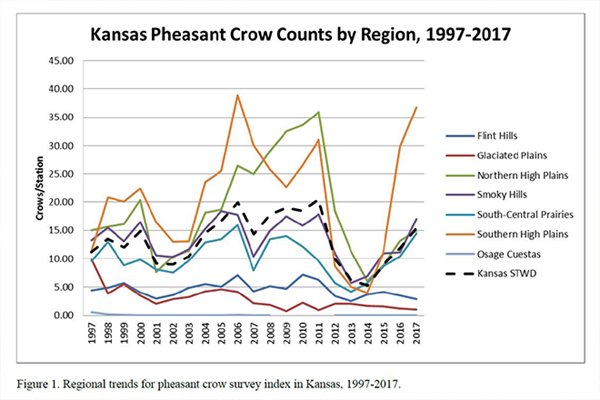Kansas pheasant hunters should be cautiously optimistic for the 2017-2018 pheasant season after preliminary survey results showed that spring crowing counts – the number of crows heard from rooster pheasants – increased 29 percent throughout the state compared to 2016.
The
Pheasant Crowing Survey represents two important life stages for ringneck populations in the state: (1) over-winter survival for a population (2) previous breeding season success. While spring crow counts usually do not predict fall populations well, they do indicate breeding population potential. The regional breakdown of the Kansas Pheasant Crowing Survey is as follows: Flint Hills (-19 percent), Glaciated Plains (-22 percent), Northern High Plains (+16 percent), Southern High Plains (+16 percent), Smokey Hills (+55 percent) and the South-Central Prairies (+27 percent).

Kansas pheasant populations continue to thrive across their primary range. As weather has improved, pheasant populations have demonstrated their ability to recover quickly, with indices on many routes increasing > 100% in a single year, and several regions reaching near record highs from record lows only three years prior. Spring rains have created excellent nesting cover and should produce good brood habitat across the primary pheasant range in 2017,
but conditions from late-June through August will dictate survival. Brood survey data will be collected in late July and August, and summarized in early September. Fall population estimates will be much more accurate once this data is available.

Supporting diverse wildlife habitat and the economic stimulus provided by pheasant hunting throughout the state, Kansas’ Department of Wildlife, Parks & Tourism has partnered with Pheasants Forever and a multitude of other supporting groups to implement the
Kansas Pheasant Initiative. This initiative uses a focus-area approach, providing cost-share and incentives for practices that create and maintain pheasant habitat. Because widespread, isolated efforts have proved less effective, the Pheasant Initiative is directing resources into focus areas to promote connectivity of projects and facilitate landscape-level population increases. Two focus areas are currently being implemented in the Smoky Hills and Northern High Plains Regions, correlating with crowing count increases for 2017.
Kansas Pheasant Initiative Progress (2016-2017)
While delays in 2016 left little opportunity to achieve progress toward habitat goals during the initial year, promotion of the program has ramped up and provided far more opportunity for 2017. To date, 229 acres of perennial habitat and 3,551.74 acres of annual habitat practices were established. The progress that has been made to this point is encouraging. While there appears to be a more limited interest in state and partners habitat objectives in the Norton area based on obligated contracts, 1 planned brood strip project for the Norton Area was cancelled in 2016 due to excessive crop residue preventing the necessary cover to be established. An additional brood strip project is planned for 2017, but may face similar challenges. Project biologists will meet in fall of 2017 to discuss additional targeting opportunities and/or changing priorities for partner funding.
Written by Jared Wiklund, Pheasants Forever’s Public Relations Manager
*Information is used from the 2017 Kansas Pheasant Crowing Survey
Photo credits: Main image – Steven Earley; Subsequent Images – Kansas Department of Wildlife, Parks, and Tourism